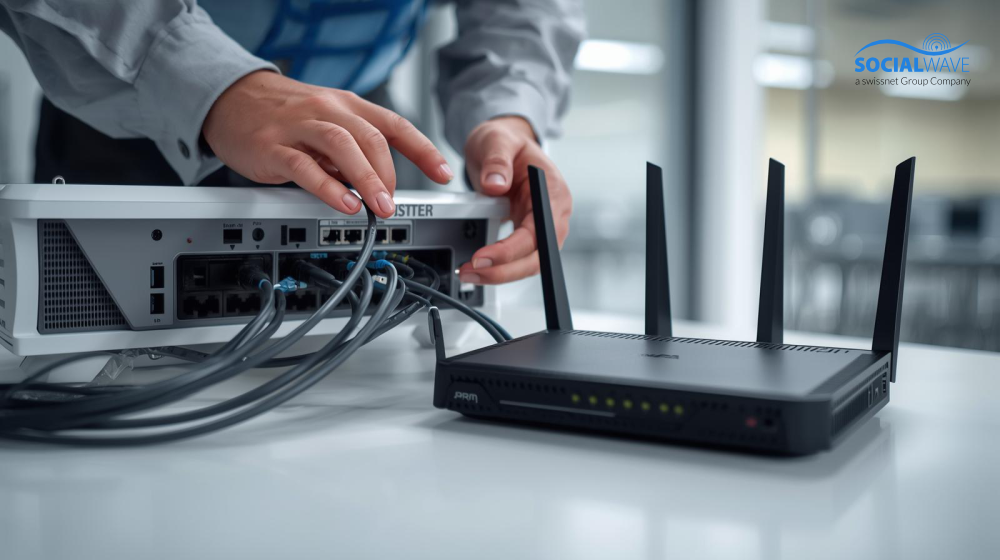The biggest WiFi issues and how to fix them

Nowadays, almost everyone has WiFi in their home and many public places and shops also offer free WiFi. However, in many places, the coverage of the desired area does not work as optimally as would theoretically be possible. The reason for this is the many different interference factors that a WLAN network is exposed to and which can prevent it from functioning. These disruptive factors may include the placement of the router or special features in the construction of the building. Such WLAN disruptors significantly reduce the effectiveness, performance and, above all, the range of the connection. Poor WiFi coverage in your shop or location can give customers a negative opinion of you and you could potentially lose them. To prevent exactly that from happening, we will show you the biggest WiFi interference factors and how to fix them.
WiFi interference factors
The many different interference factors for WLAN can generally be divided into three categories. On the one hand, these are structurally related disruptive factors that have to do with the building that you want to cover with WLAN. In addition, electrical devices interfere with the functionality of the network and finally, you can set up the router yourself in the wrong location and thus reduce the effectiveness of the WLAN network.
- Structural disruptive factors
If you look at the structural interference factors, there are various objects here that can have an influence on the signal strength of the WiFi. If you look at the walls of a building, they are probably the biggest disruptive factor. If a wall is very thick or contains water pipes, the WLAN only gets through poorly and behind the wall the signal can be very poor or non-existent. In addition to walls, floor heating, plants and water-containing building materials such as concrete or bricks also interfere with reception. But what is the reason for that?
The reason is that water and WLAN radio waves are on the same wavelength, which means that water absorbs the WLAN waves and only gets through a small amount of time. In addition to water, glass and metal also interfere with radio waves and lead to poorer reception because they reflect the waves and thus the WLAN does not reach where it needs to go.
2. Electronic interference factors
In addition to water, metal and glass, WLAN radio waves are also interfered with by waves or radiation from other electrical devices. In particular, electronics that emit radiation themselves are extremely disruptive to WLAN. For example, Bluetooth devices, microwaves, game consoles, or other wirelessly connected electronics such as SONOS speakers and surveillance cameras. All these different radiation and the various radio waves interfere with each other and, in particular, reduce the range of the WLAN network. This is because WLAN networks transmit on two different radio frequencies: 2.4 GHz and 5 GHz. And it is precisely at these frequencies that most of the other devices mentioned above transmit and because these devices must share the frequency ranges, they reduce each other's output. However, the devices that have the biggest impact on your WLAN reception are not your own, but the routers of your neighbors. This is because they send exactly the same signal as your own router on the same frequency, causing the devices to interfere with each other.
3. Router positioning
The third category of WiFi interference factors that can affect the performance of your WiFi network is router placement. Because how and where you set up your WiFi router can have an enormous impact on your network. The placement of the router is closely linked to the structural conditions in your building, but not affected by this alone. Because the height of the router or the furniture nearby are also relevant here.
Fixing WiFi interference factors
Even if you are aware of all these WiFi interference factors, you must also fix them to ensure optimal performance of your WiFi network. That's why we'll show you a few simple tricks to avoid the most common WiFi disruptors.
The evasion of the structural factors and sub-optimal placement of the router are summarized here, as the solution to both problems is related. First, it is most effective if the router is as central as possible so that it can transmit the WLAN in all directions. You should also note where the structural disturbance factors are located, i.e. look at the walls. This allows you to see where the WLAN can be most disturbed by the location of taps, windows or metal components. You should keep your router away from these walls as much as possible. Once you've found a location where you can place your router, be sure to install the router at a high location, as this can improve the range of the WiFi network.
Apart from the structural WLAN interference factors, there are of course also electrical devices that impair performance. Especially in a shop or restaurant, you often have no influence yourself on which devices are on site and how they work. So in particular, you should adapt the devices over which you definitely have sole control.
First and foremost, the router should be mentioned here. You can optimize a lot of things on this to improve your WiFi network. First, you should always keep your router's firmware up to date. Also make sure that the router's antennas are correctly oriented. If you have three antennas, you should point one of them vertically upwards, one horizontally forwards and the third antenna horizontally to the side. If your router has two antennas, it is best to orient one vertically and one horizontally. If your router has removable antennas, you can also buy and install stronger antennas, which will increase the range of your network.
To avoid interference from other devices, you can also switch from the 2.4 GHz frequency to the 5 GHz frequency, as this frequency is generally used significantly less and therefore fewer devices cause interference. Before making this switch, however, you should check whether your router and devices are designed for this purpose, otherwise you will not be able to receive the 5 GHz frequency. Exactly how this switch works is different for each router, so it's best to consult the manual. Finally, if your router has removable antennas, you can install better antennas, which should increase the range of your network.
Access points as a simple complete solution
Another solution that at least partially eliminates all previously mentioned WLAN interference factors is the use of access points. Access points, or AP for short, are basically small WLAN routers that are not connected to the socket in the wall themselves, but to the original router. In doing so, you imitate the router's signal and thus offer end devices the opportunity to connect to a “router” directly in their vicinity, instead of to the real router, which may be much further away or affected by interference factors. Depending on the size of the area to be covered, any number of access points can be connected and the connection between the router can take place either by cable or by airlift. However, an airlift has the disadvantage that it works via WLAN and is therefore again susceptible to all WLAN interference factors.

If access points bypass all WLAN disruptors and thus make the network extremely effective, why isn't everyone using them? The reason for this is that setting up the access points so that everything works so optimally in the end is relatively complicated and requires experience with the topic. And it is precisely at this point that the benefits of Socialwave WiFi marketing package one. Because if you let Socialwave provide the WLAN in your shop or restaurant, then on the one hand, you have a router that is optimally set up and always kept up to date, and Socialwave also offers comprehensive support in setting up the access points so that you can use them directly and offer the best possible WLAN network.
conclusion
The performance and range of a network are affected by many different WiFi interference factors. These include the structural conditions in the building, such as pipes or metal in the walls. Other electronic devices, such as microwaves or game consoles, but especially third-party routers, are also interfering with the range of your network. And finally, the router itself should also be optimally placed. There are individual solutions for each of these problems, but access points can also be used. Since these are not easy to set up, it is recommended to use the help of experts. Socialwave can be used with WiFi marketing package help with this, because we offer comprehensive assistance in setting up your network, including access points.









.svg)

.svg)
.svg)



